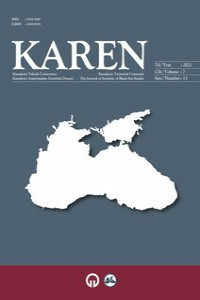SİNOP İLİ BOYABAT İLÇESİ KENTSEL SİTİNDE MESLEK YÜKSEKOKULU ÖĞRENCİLERİNE ORYANTASYON AMAÇLI ROTA ÖNERİSİ
Artan nüfus ile birlikte meydana gelen yoğun yapılaşma, tarihi yapıların terkedilmesi, bayındır etkileri, doğal afetler gibi birçok etken, kentlerdeki doğal ve kültürel mirası tehdit etmektedir. Günümüze kadar varlığını korumuş kültürel mirasın devamlılığını sağlamak için doğru koruma önlemlerini öğretmek ve kültürel miras bilincini yerleştirmek adına yüksekokullarda verilen eğitimlerde, yapıları görerek öğrenmenin etkisi oldukça önemlidir. Bu önem göz önüne alındığında, Boyabat Meslek Yüksekokulu Mimari Restorasyon Programı öğrencilerinde ve ilçede farklı bölümlerde eğitim gören öğrencilerde kültürel mirasa yönelik bir ön bellek oluşturma amacı ile kültürel oryantasyon rotası oluşturulması amaçlanmıştır. İlçede kentsel sit alanı içerisinde tescilli yapıların yoğun bulunduğu bir bölge seçilerek hazırlanan rota güzergâhında cami, çeşme, okul binası ve sivil mimari örneklerini bir arada sunan, bir rehber hazırlanması amaçlanmıştır. Rota boyunca karşılaşılan yapılardan bazılarının, yapı malzemesi, tipolojisi, sokak dokusu vb. özellikleri hakkında bilgiler aktarılmıştır ve öğrencilerin kentin genelinde yapacakları gezilerde yapılara daha bilinçli bakmaları hedeflenmiştir. Sonuç olarak öğrencilere oryantasyon amaçlı hazırlanan bu rota çalışması, ileride Boyabat ilçesi için hazırlanacak kültür rotaları için rehber niteliğin taşıyacaktır.
Anahtar Kelimeler:
Kültürel Oryantasyon Rotası, Boyabat, Sinop, Mimari Restorasyon, Kültürel Miras
BOYABAT ROUTE SUGGESTION FOR CULTURAL ORIENTATION FOR VOCATIONAL SCHOOL STUDENTS
Many factors such as intensive construction, abandonment of historical buildings, flourishing effects, natural disasters that occur with the increasing population threaten the natural and cultural heritage in cities. In order to ensure the continuity of the cultural heritage that has preserved its existence until today, the effect of learning by seeing the structures is very important in the education given in the colleges in order to teach the right protection measures and to place the awareness of cultural heritage. Considering this importance, it is aimed to create a cultural orientation route in order to create a pre-memory for the cultural heritage for the students of the Architectural Restoration Program of Boyabat Vocational School and the students studying in different departments in the district. It is aimed to prepare a guide that presents mosques, fountains, school buildings and civil architecture examples together on the route route, which was prepared by choosing a region where registered buildings are concentrated in the urban protected area in the district. Some of the buildings encountered along the route, building material, typology, street texture, etc. Information about the characteristics of the buildings was given and it was aimed that the students would look at the buildings more consciously during the trips they will make throughout the city. As a result, this route study, which was prepared for the purpose of orientation to the students, will serve as a guide for the cultural routes to be prepared for the Boyabat district in the future.
___
- Başoğlu, Bekir (1990), Boyabat Yöresi Araştırmaları. Boyabat: Boyabat: Boyabat Matbaası.
- Schiller, Preston L.- Bruun, Eric C., & Kenworthy, Jefrrey R. (2010), An introduction to sustainable transportation : policy, planning and implementation. Londra: Earthscan.
- Seçkin, Nadide - Özakın, Rabia - Erdem, Ayten (2003). “Sinop-Boyabat Kentsel Mimarlık Envanter Raporu 2002 Yılı Çalışması”, TÜBA-KED Türkiye Bilimler Akademisi Kültür Envanteri Dergisi, sayı 1 (Mart): 90–128. https://dergipark.org.tr/tr/pub/tubaked/issue/57283/810198#article_cite.
- Selimoğlu, Pınar (2016). Geleneksel Boyabat Evleri. Yayımlanmamış Yüksek Lisans Tezi, Konya: Selçuk Üniversitesi Fen Bilimleri Enstitüsü.
- ______(2013), Sinop Tarihi ve Kültür Envanteri. T.C. Sinop Valiliği İl Kültür ve Turizm Müdürlüğü.
- Zeyrek, Ahmet G. (2013), "Boyabat İlçe Analizi". Kuzey Anadolu Kalkınma Ajansı. https://www.kuzka.gov.tr/Icerik/Dosya/www.kuzka.gov.tr_18_WW9W32SE_boyabat_ilce_analizi.pdf (04.05.2022).
- ISSN: 2458-7680
- Başlangıç: 2015
- Yayıncı: Karadeniz Teknik Üniversitesi
Sayıdaki Diğer Makaleler
HOVHANNES KAÇAZNUNİ’NİN HAYATI
Fatma Nur GÜCÜYENER, Hüseyin SARAÇ
ORTA ÇAĞ GÜRCİSTAN'INDA EĞİTİM XI-XII YÜZYILLAR
OSMANLI DEVLETİ’NDE MODERN HAPİSHANE SÜRECİNE GEÇİŞTE GEREDE HAPİSHANESİ
KOMPOZİT YAY ÇITALARINA KURUL KALESİ’NDEN YENİ BİR KATKI
